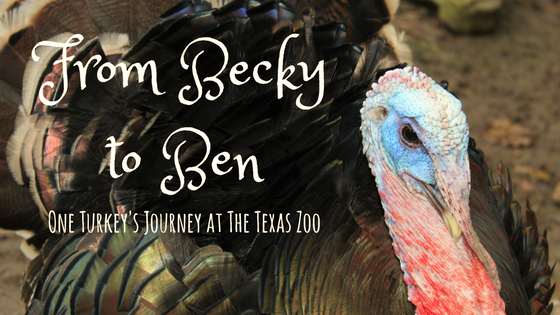
In early Spring of 2017, a young turkey made their debut at The Texas Zoo. With such a sweet and chirpy disposition, our caregivers decided to bestow the name of Becky unto the turkey. As Becky's appetite grew, so did Becky. Quickly, her outward appearance began to change, and her chirps turned more gobble like. As her feathers became more bold and the snood on her beak elongated, we realized Becky was really a Ben. The name was chosen in honor our nation's founding father, Ben Franklin.
As plouts, or babies, both male and female turkeys have similar colorization to help them blend in with their surroundings and hide from predators, so it is not uncommon to realize you made a mistake a few months down the road. Turkeys undergo five significant molts (feather replacements) in their lifetime: natal, juvenile, first basic, alternate (first winter), and basic, which is their adult plumage. Once they molt their juvenile feathers, they have between 5,000 to 6,000 feathers adorning their 20 pound bodies. In toms (male turkeys) these feathers will be vibrant, iridescent copper, bronze, red, green, and gold.
Additional to their striking feathers, toms develop other secondary sexual characteristics, which all aid him when it comes time to attract that special hen. Toms grow a beard on their chest and across their beak a red, fleshy appendage called a snood. While females also have snoods, they are not as elongated or vivid. Along with the visual differences, toms vocalize with a gobble while hens cluck and chirp. This is why male turkeys are better known as gobblers.
Rio Grande Turkeys can be found in the wooded and grassland areas of Southern, Central, and Northern Texas. They are the most widely spread turkey species in Texas, which allows people all over this great state to witness their beauty and intelligence.
Many think of turkeys as bird brains, but they are remarkably intelligent. In fact, for this reason (and the fact multiple species of turkey can be found throughout the country) they were almost our National Bird. Our founding father, Ben Franklin was very adamant about bestowing the turkey with this honor, but in the end the Bald Eagle was chosen (not that we are complaining). Bald Eagles were seen as more majestic, and as ground nesters many did not believe turkeys could fly. This is untrue! Turkeys are able to fly for short distances and roost in trees at night to avoid predators like coyotes and bobcats.
Turkeys are not only beautiful, but intelligent, sentient creatures, so the next time you are at The Texas Zoo make sure to stop by our deer yard to see Ben strutting his stuff. He will come right up to the fence in attempt to impress you, with the hopes you may throw some corn or petting zoo feed in as a snack. In the meantime, keep gobbling!

